Weekend trip to Bavaria: Day 3 – Munich (Pt2)
Germany and beer go together hand in hand, and Munich is quite well known for its beer festival – Oktoberfest. Of course, at the time of the year that we were there visiting the city we could not experience that massive celebration, but we still had to try some beers.
And where to go? Well, to the largest tourist attraction, the world’s most famous tavern - Hofbräuhaus.
Located in the city center, at a walking distance from Marienplatz, but from the opposite where we had been before, we can find Hofbräuhaus am Platz, a beer hall originally built in 1589 by Duke Maximilian I as an extension of the National Brewery of the Court of the Bavaraian Kingdom (“Staatliches Hofbräuhaus in München”).
From Sendlinger Tor, where we were, we just followed the central street Oberanger-Rindermarket, quickly getting back main square. Here, to the right, stand two important landmarks of the city: Peterskirche and Alte Rathaus, mixed in the typical German house buildings that decorate the Old Town of Munich.
St. Peter’s cathedral is another one from the gothic period, being the oldest parish church of the city, locally known as Alte Peter. From the top of the tower clock (after climbing 299 steps) you can enjoy splendorous panoramic views. The inside of the church is quite beautiful, marked by the exquisite ceiling fresco and the baroque style choir that opens the way to the major central piece, which is the high altar.
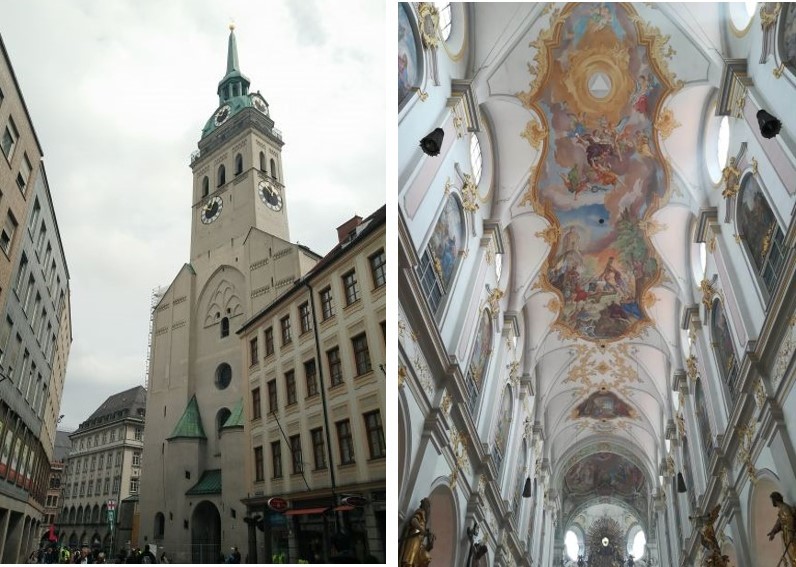
Peterskirche seen from Rindermarkt (left) and its interior (right).
Right next to Petersplatz we spot the Old Town Hall, very distinctive in style and colour when compared to the New Town Hall, but equally impressive. In front of it appears the catholic church of the Holy Spirit – Heiliggeistkirche – in a wayclosingthis historical quarter of the city.
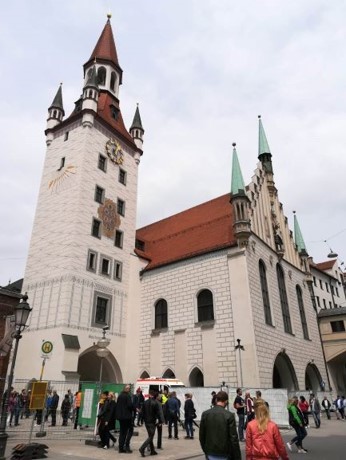
Walking around Munich historical center - Alte Rathaus, seen from Viktualienmarkt
At this point we were entering the enormous Farmer’s market – Viktualienmarkt – where several food and beer stands attract many tourists to grab something to eat or drink. You can sit here and relax, in the company of friends, or you can also do your grocery shopping thanks to the many fruit, fish and meat stands.
Back to what was the start of this text, we continued way to our destination, the Hofbräuhaus, that also houses the restaurant, Hofbräukeller. Inside you will find an interesting decoration, warm and welcoming, and the waiters are dressed in traditional Bavarian clothes - "Dirndl" for the women and "Lederhosen" for the men. As we were there during “regular hours”, there was a band playing traditional Bavarian tunes and this was definitely a highlight of our trip!
We took some time to rest here, try the famous (and very good! ) beer and enjoy the Bavarian way of life. I absolutely recommend it!
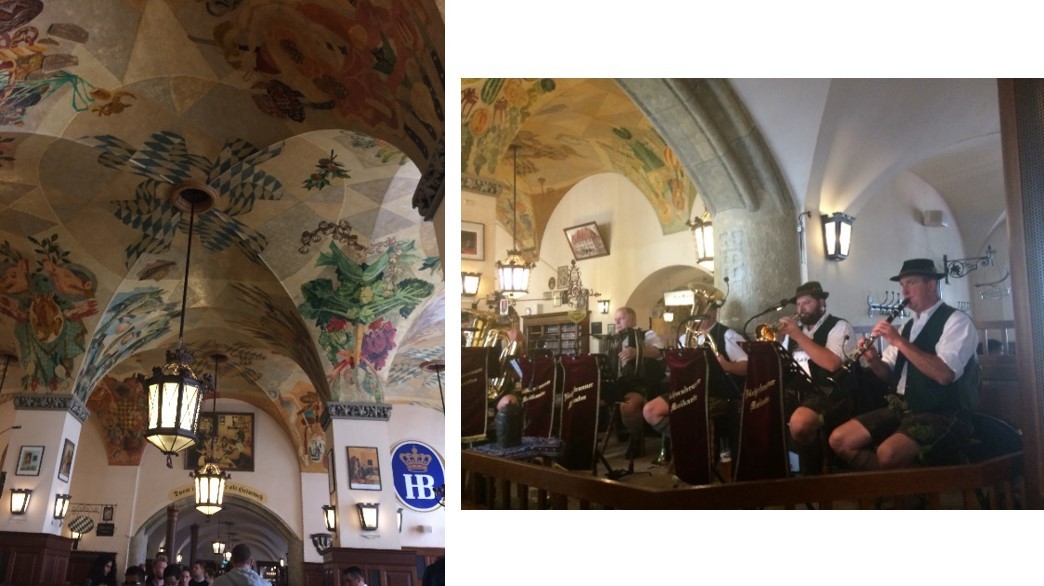
Inside of Hofbräuhaus am Platz.
The menu features traditional favorite dishes of the Bavarian cuisine, for instances the “Brezn” (soft pretzel), the “Obatzda” (cheese dip), the “Hax'n” (knuckle of pork) and tasty sausages such as “Bratwurst” and “Weisswurst”. Brews include “Helles”, “Dunkel” and “Weißbier”.
As this was more or less a lunch to us, we shared a salty pretzel and a pint of beer. Because we are Portuguese, we are not used to being given 1L of beer when we ask for it, so of course that one for each would be too much for us at that time of the day!
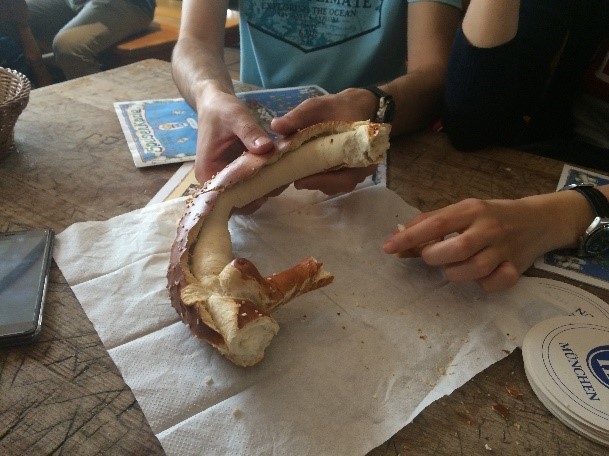

Sharing beer (Dunkel) and pretzels @ Hoffbräuhaus am Platz
Fully satisfied, we strolled our way to another major sight of Munich, this time on the other side of the river Isar, which meant walking along the road Maximilianstraße.
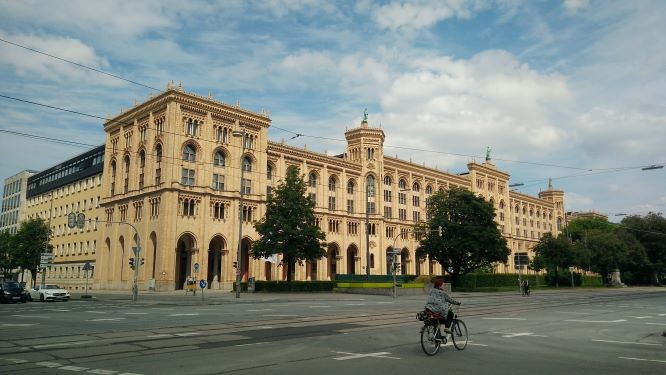
“Regierung von Oberbayern”, house of the District Government of Upper Bavaria, seen from Maximilianstraße
We took the occasion to have a look at another important church in Munich, turning right towards Marianneplatz.
Here stands, since the late 19thcentury, the largest protestant church in town, St. Lukas, which is actually the only preserved Evangelic-Lutheran parish church in the historical area, right by the banks of the Isar. With its Romanesque brick exterior and the typical blueish dome, it is a rather imponent monument.
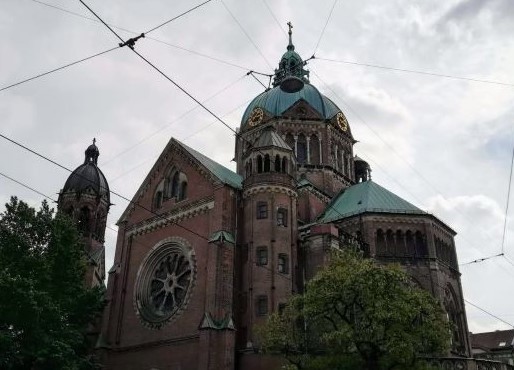
St. Lukas church, at Marianneplatz
Crossing Maximilianbrucke over the Praterinsel, we were reaching our destination. The Maximilianeum Foundation is a private educational institution, notorious not only by its excellence level but also the remarkable building in neo-renaissance architecture where students are lodged, having been founded in 1852 by King Maximilian II of Bavaria.

Walking and walking… Maximilianeum Foundation in the back
The purpose was that of granting gifted Bavarian students an opportunity to conduct superior studies in Munich without financial concerns. Nowadays, both men and women can be accepted to this prestigious institute, but from hundreds of candidates who apply, only a maximum of eight are admitted every year.
Already being 4 pm, we were perfectly in time to continue our tour around Munich, and thus decided to proceed to one of the most acclaimed venues of the city, the Englisher Garten. Because we were quite tired of walking, we decided to catch the tram, and it felt amazing to sit again! Wait for part 3 of this article, the last of our day in Munich!
Photo gallery
Content available in other languages
Want to have your own Erasmus blog?
If you are experiencing living abroad, you're an avid traveller or want to promote the city where you live... create your own blog and share your adventures!
I want to create my Erasmus blog! →























Comments (0 comments)